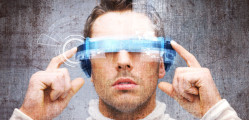The emergence of virtual reality (VR) provides users with the opportunity to have new experiences. For mental health practitioners, VR is the gateway into the world of patients suffering from mental health issues such as anxiety disorders and phobias.
According to the World Health Organisation (WHO), one in four people around the globe have suffered, suffer, or will suffer, from some form of mental disorder. Research shows that patients suffering from mental health disorder die 25 years earlier than the national average.
Part of the problem is a lack of efficient training given to family GP’s. In most cases, patients suffering from cognitive issues can go undetected for years. Even when mental disorders, which include stress and depression, is diagnosed, patients are often prescribe drugs that are ineffective.
Pioneers within the medical field are looking for new ways of treating patients without pharmaceutical intervention. Given the former Glaxo chief, Dr. Allen Roses admitted that over 90% of pharmaceutical drugs manufactured by Big Pharma do not work on 30-50% of patients, it is obvious that alternative measures are called for.
VR therapy
VR technology is not new to the medical industry. Therapists have used a virtual reality program called Bravemind, developed at the Institute for Creative Technology, since the early 1990’s. The application has mostly been used to help patients and war veterans suffering from post-traumatic stress disorder.
Although virtual reality exposure therapy (VRET) has been used in safe and controlled environments for almost 30 years, due to the limitation of VR technology and a lack of clinical evidence, data to support the effectiveness of VR as an effective treatment is inconclusive.
The emergence of mobile VR headsets in recent years presents new opportunities. Not only can affordable equipment be used to treat more patients, but a new approach to treatments that attempt to tackle mental health issues is also being addressed.
In the UK, PhD student, Nick Peres is pioneering an educational VR concept at Torbay Hospital in South Devon. PatientVR uses Oculus Rift DK2 goggles with a full 360-degree view of the surroundings. The footage puts medical practitioners in the shoes of patients suffering a panic attack.
For the time being, the program is being used as a training tool to give trainee doctors a perspective of the cognitive experience overwhelmed patients are experiencing. Afterwards, students are debriefed about the patient’s state of mind and the best cause of action to take in such circumstances.
Peres told Wired magazine that the experiment with VR is “relatively low risk because it’s part of the education route.” If funding is secured, VRPatient can be used as an effective training tool to help medical staff empathise with patients.
How does virtual reality work?
Virtual reality works by placing goggles over your head to block out natural senses to the outside world. Using 3D imaging to create alternative environments, VR creates a fully immersive environment that makes the brain think what you are seeing and hearing is really happening.
Because every experience we have is recorded by the subconscious mind and communicated to the brain, the subconscious can be tricked into believing events we experience in VR are a true representation of our actual reality. As a result, the subconscious sends different communication signals to the brain that ultimately makes users think, feel and act differently in the real world.
In theory, VR can be used to help people overcome fears by working on the principle that what can be caused by the brain can be cured by the brain. A high percentage of mental disorders are the product of past traumas the brain has subsequently manifested into a story that “creates” a problem, even when a problem doesn’t really exist.
The vast majority of research using VR for treating mental disorders has been funded by the US military. However, more recently, private companies in Europe have been developing various VR therapy applications and are taking a different approach to previous testing in the hope of finding better results.
One such company is Beyond Care from the Netherlands. The Dutch company is working on a VR solution that uses natural eye movement desensitisation and reprocessing (EDMR). The treatment works by asking patients to recall a traumatic memory whilst following a moving object.
The objective is to overtax the working memory so the traumatic memory is replaced by current events and eventually becomes less vivid. After repeated exercises the memory loses the capacity to trigger an emotional response to the trauma.
What types of mental illnesses can VR be used to treat?
In theory, the potential for VRET is boundless. New studies in neuroscience are discovering the mind has natural healing powers. Healing works on the basis of how patients think and believe their illness is being treated. Advocates such as Dr. Deepak Chokra and Professor Bruce Lipton Phd, claim the healing power of the human mind has been used in medicine for thousands of years.
There is also a mounting body of evidence that shows a significant number of spontaneous regressions doctors cannot explain is a real phenomena. Such cases have been attributed to patients that believed they were being cured much like patients that are treated with a sugar pill to trigger a placebo effect.
VR therapy can essentially be used as a placebo to alter the neurons in patients that suffer from traumas that subsequently result in mental health issues. Such as breakthrough could save the NHS up to an estimated £41.8bn a year.
To date, virtual reality headsets are being used to treat anxiety disorders and phobias such as a fear of flying, a fear of heights, stress relief, public speaking, storms and blood. Virtually Better has teamed up with leading academic institutions to research R&D projects involving childhood anxiety and childhood social disorders.
Swedish electronics company, Mimerse is developing a gamified psychological treatment tool which uses VR to deliver digital treatments without the patient needing to consult a real-world therapist. The application, known as “Itsy” is the first game-based treatment available on the mass market.
Although VRET is still in its infant stages, developments in the technology, together with findings in neuroscience, could produce groundbreaking and effective treatments that will cure anxiety and phobias on a large scale for a low cost. Let’s face it, pharmaceutical drugs are failing to deliver. Maybe technology will succeed.
If you would like to find out more about Virtual Reality, give us a call on +44 (0)207 148 0526 or contact us on info@sbanimation.com.
Also, check out our website and social media here:
https://www.facebook.com/slicedbreadanimation/




Leave a Reply